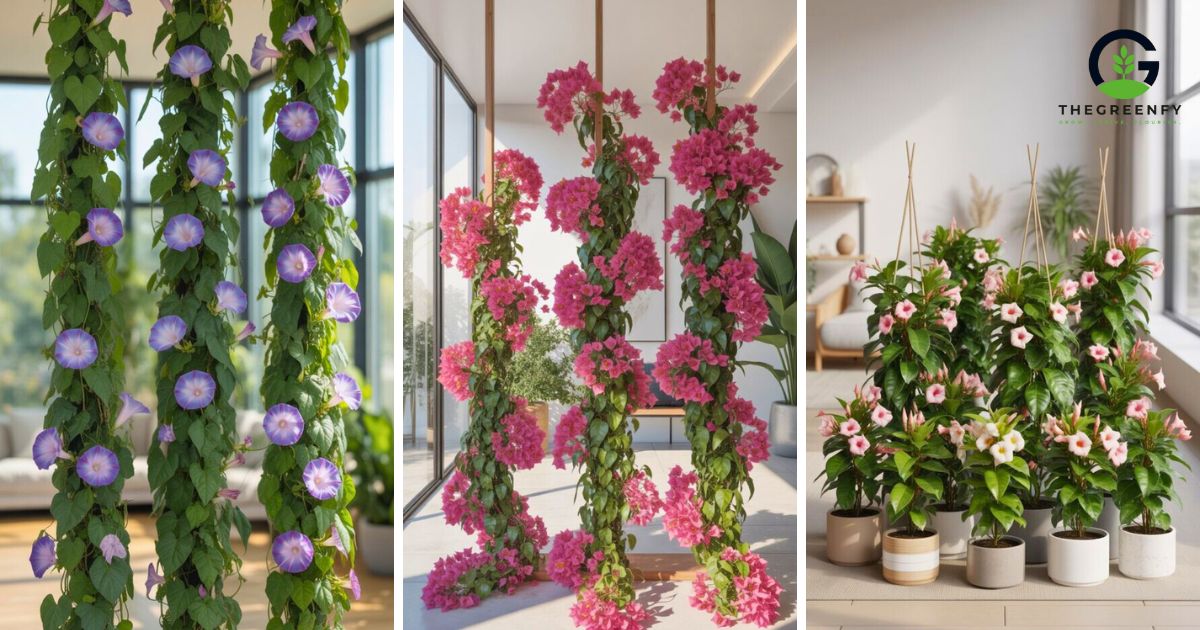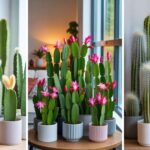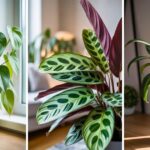Indoor climbing plants can add so much life and beauty to any room. They bring a fresh, natural vibe that makes my space feel inviting.
I’ve noticed climbing plants work in both small and large areas. Whether your place is full of sunlight or a bit dim, there’s a plant for you.

Climbing plants aren’t just pretty—they help clean the air and make your home feel more alive. Some trail from shelves, others climb up supports, and honestly, there are tons of easy-to-care-for options out there.
Let me share 20 climbing plants that I think can really brighten up your indoor space.
1. Monstera adansonii (Swiss Cheese Plant)

Monstera adansonii is my go-to when I want a bold, unique look. Its leaves have those wild holes—like a living piece of art.
This plant loves to climb, and a moss pole or trellis makes it happy. I keep it in bright, indirect light and water when the top inch of soil feels dry.
The vines can get long, and suddenly, any room feels like a jungle. It’s honestly hard not to smile when you see those leaves.
2. Epipremnum aureum (Pothos)
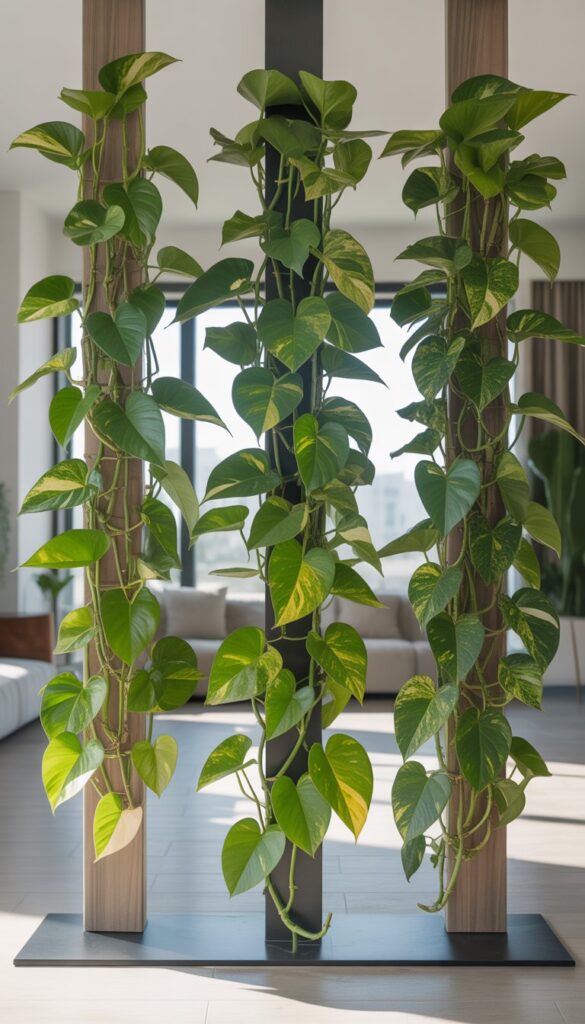
Pothos is probably the easiest climbing plant I’ve ever grown. The heart-shaped leaves and trailing vines add instant green to any spot.
It thrives in low to bright, indirect light. I train mine to climb up a moss pole or let the vines spill from a hanging basket.
Pothos is tough, filters the air, and just keeps going. I love how it fits on shelves or plant stands—no fuss at all.
3. Philodendron hederaceum (Heartleaf Philodendron)
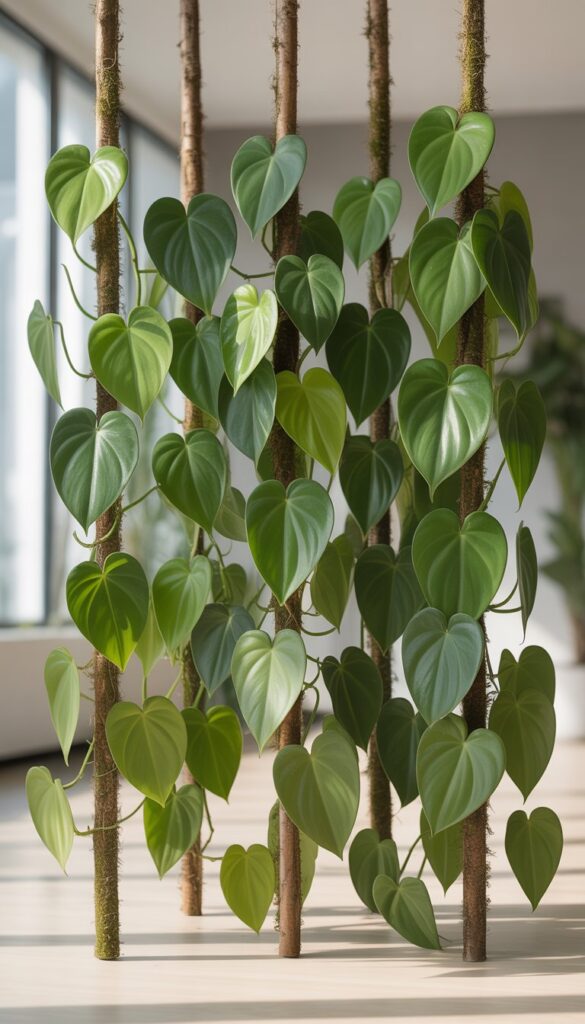
My Heartleaf Philodendron is so easy to care for. The shiny, heart-shaped leaves give my space a cozy, relaxed feel.
It grows well in low to medium light. I let it climb a moss pole, and it always looks happy.
I water it when the top inch of soil dries out. If I forget now and then, it forgives me—such a relief.
Plus, it helps clean the air. I couldn’t ask for a better plant friend.
4. Hoya carnosa (Wax Plant)
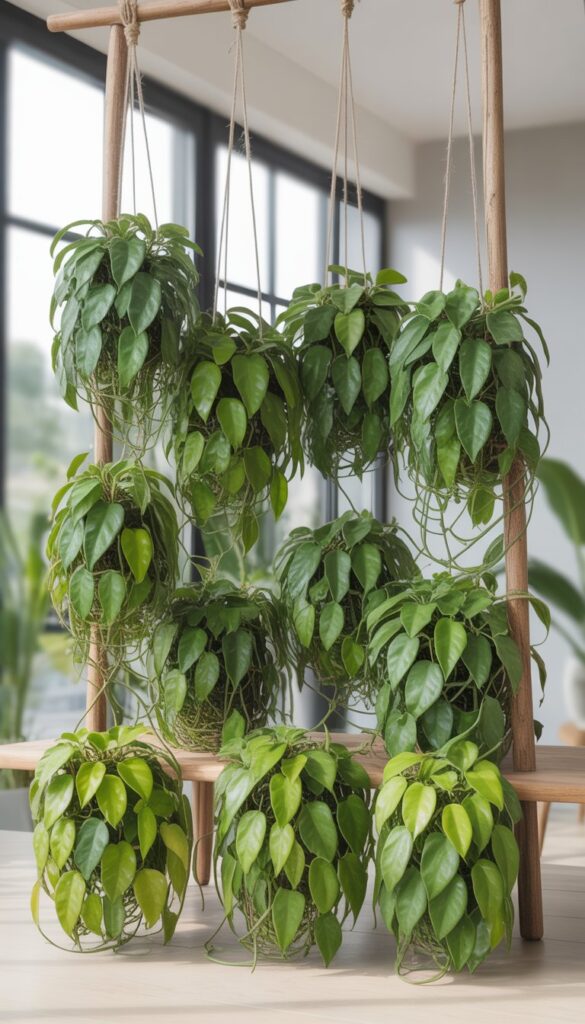
Hoya carnosa is a classic for indoor climbing. The thick, waxy leaves are tough and look great in almost any room.
When it blooms, the star-shaped flowers smell amazing. I let the soil dry out between waterings and keep it in bright, indirect light.
A bit of humidity helps it thrive. Feeding it monthly seems to bring out more flowers—always a nice surprise.
5. Ceropegia woodii (String of Hearts)
String of Hearts is just charming. The delicate, heart-shaped leaves and thin vines add a unique touch to my room.
It doesn’t ask for much. I give it bright, indirect light and water only when the soil feels dry.
The tiny succulent leaves store water, so it’s perfect for anyone who forgets to water sometimes. I’d recommend it to any plant newbie.
6. English Ivy (Hedera helix)
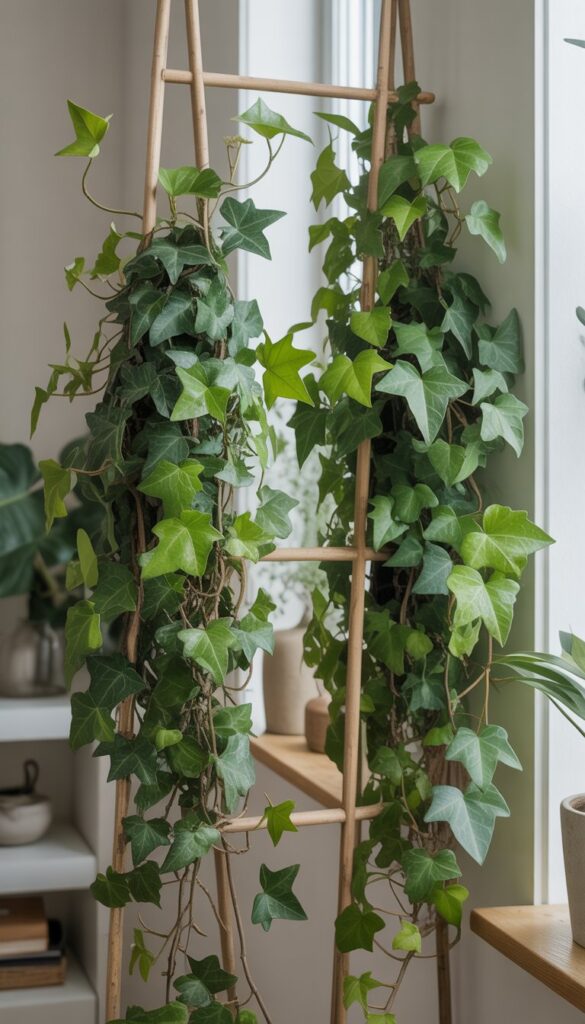
English Ivy brings old-world charm indoors. Those star-shaped leaves look great in almost any setting.
It likes partial shade and works well in pots or hanging baskets. I keep the soil moist, but not soggy—that’s key.
Training it on a trellis is a breeze, but it can grow fast. Sometimes I have to trim it back to keep things tidy.
7. Climbing Ficus (Ficus pumila)
Climbing Ficus is a solid pick for indoor vines. Its small, dense leaves make any wall look lush as it climbs.
It adapts easily to low light. The aerial roots let it cling to trellises or even walls.
If you want something that grows quickly and fills vertical space, this is it. I keep the soil moist, but never soggy.
8. Passionflower (Passiflora)
Passionflower is fascinating to grow indoors. The flowers are so intricate, you almost can’t believe they’re real.
It needs bright light and fresh air to stay healthy. I let it climb a trellis and water it regularly, making sure not to drown the roots.
Feeding it with balanced fertilizer every few weeks keeps it happy. Its fast growth and wild blooms make it a real showstopper.
9. Lipstick Plant (Aeschynanthus radicans)
The Lipstick Plant stands out with its bright red, tubular flowers—like little lipsticks popping out. It’s a tropical vine that’s perfect for hanging baskets indoors.
It loves bright, indirect light and thrives in warm, humid spots. I keep its soil moist, and it rewards me with more blooms.
This plant is easygoing, so it’s great whether you’re just starting or already obsessed with plants.
10. Black-eyed Susan Vine (Thunbergia alata)
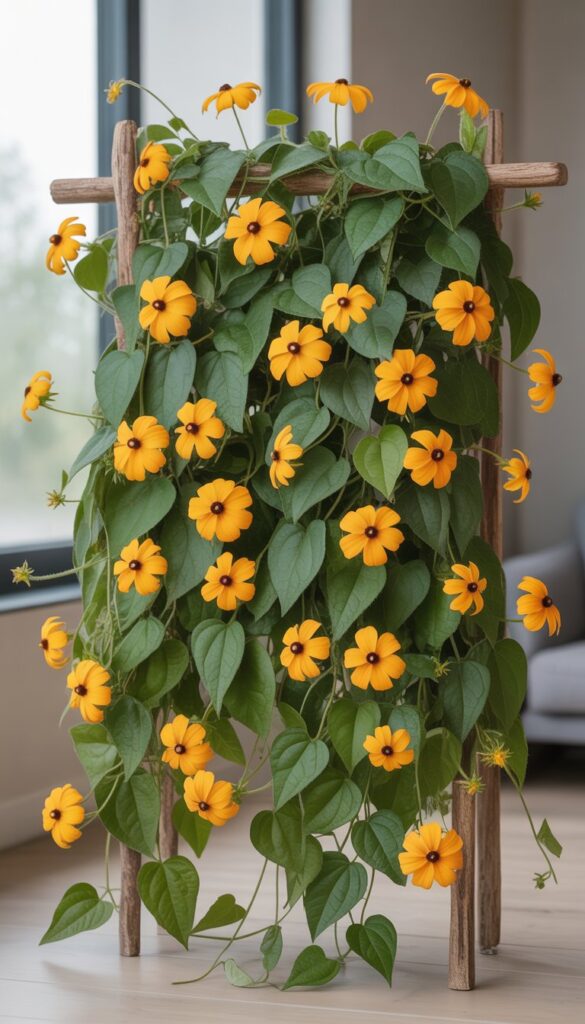
I love how fast the Black-eyed Susan Vine grows. The orange and yellow flowers with dark centers brighten up any space.
It prefers full sun or partial shade. I water it often but make sure the soil drains well, especially in hot, sunny spots.
It’s great for hanging baskets or climbing a small trellis. If you want something cheerful and easy, this one’s a winner.
11. Sweet Potato Vine (Ipomoea batatas)
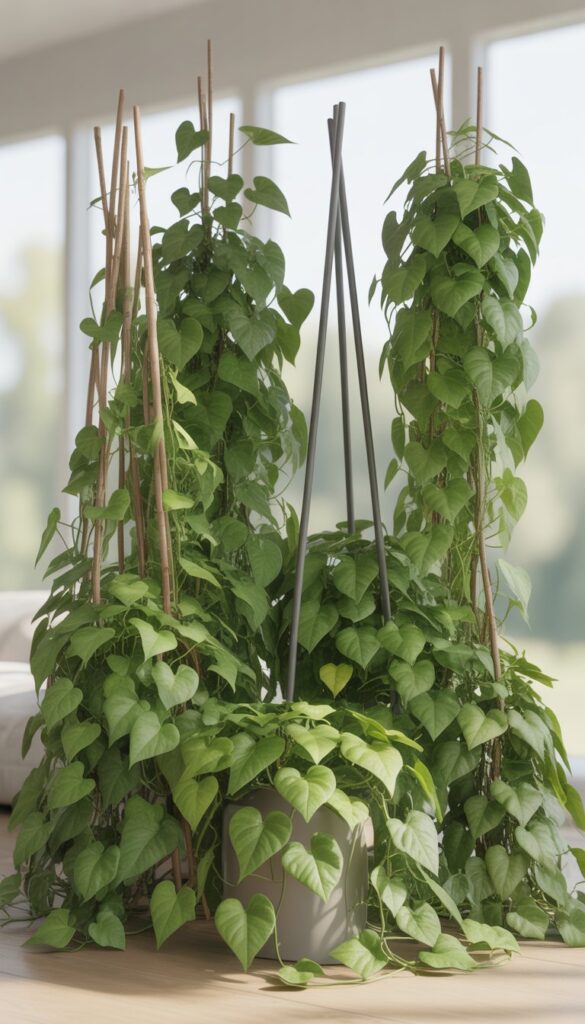
Sweet potato vine is a fun, fast grower indoors. The heart-shaped leaves come in shades from green to deep purple and almost black.
It looks great in containers or hanging baskets. You can let it spill over or help it climb a trellis.
I give it plenty of bright light and water when the soil feels dry. It’s simple, colorful, and always makes me smile.
12. Stephanotis floribunda (Madagascar Jasmine)
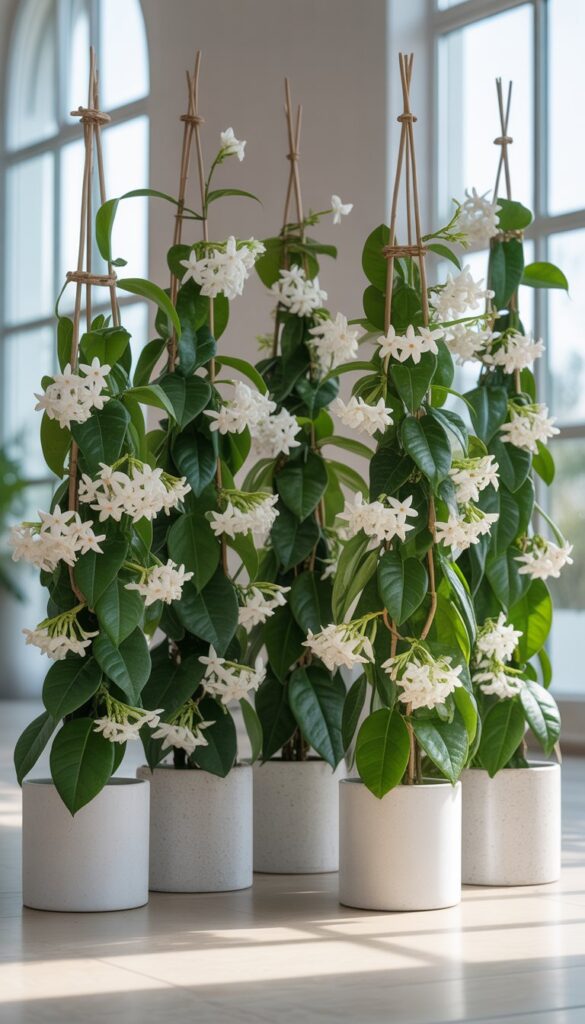
Stephanotis floribunda, or Madagascar Jasmine, brings elegance to any room. The glossy leaves and white flowers look beautiful, and the gentle scent fills the air.
It needs bright light—about 4-6 hours of sun—and warmth. I keep the soil moist but well-drained and feed it monthly in spring and summer.
A wire frame helps it climb and show off those blooms. Just keep it away from cold drafts; it really doesn’t like the cold.
13. String of Pearls (Senecio rowleyanus)
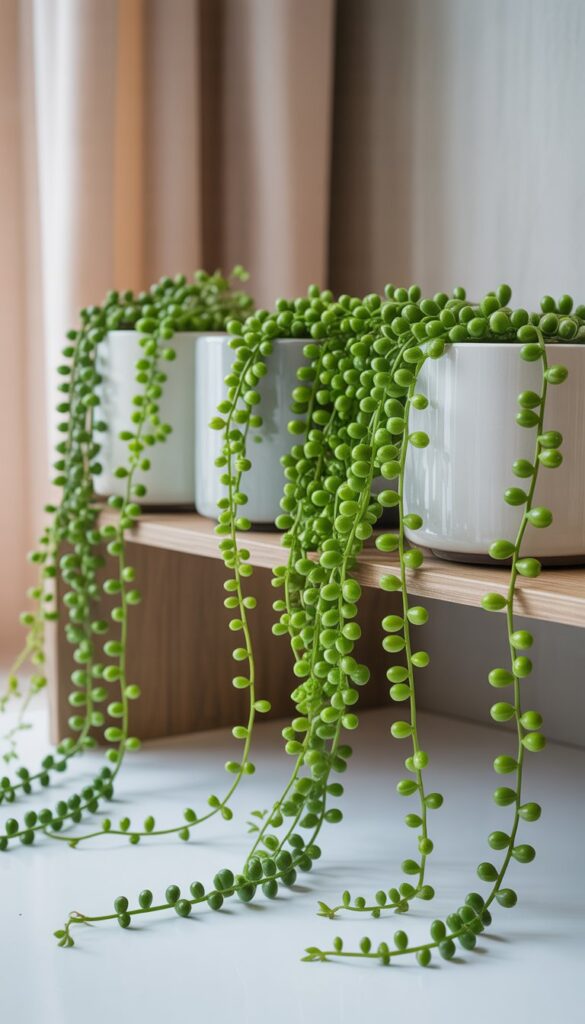
I really enjoy growing String of Pearls. Its small, round leaves look like tiny green beads strung along thin vines.
This plant grows well indoors. It’s great for hanging pots or shelves, giving a playful look to any space.
It needs bright, indirect light—think near a south or west window, but not in the harsh sun. I try not to water it too much since it stores water in its leaves and likes the soil on the dry side.
Once you get the hang of its needs, String of Pearls is easy to care for. Its trailing chains add something unique to my indoor garden.
14. Bougainvillea
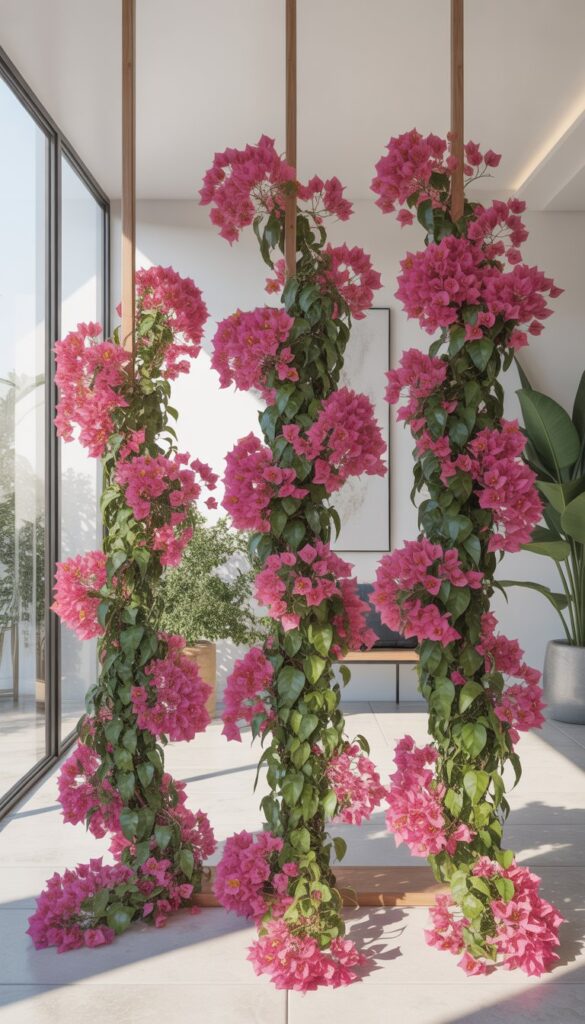
I love growing bougainvillea indoors for its bright, colorful bracts. It needs a lot of sunlight—at least 5-6 hours a day—to really show off those blooms.
This plant climbs easily and brings a vibrant energy to any room. Rich soil helps it thrive, and I feed mine with food made for bougainvillea or hibiscus.
I prune it every year to encourage new growth and keep it looking tidy. It’s definitely a cheerful addition to my space.
15. Crossvine (Bignonia capreolata)
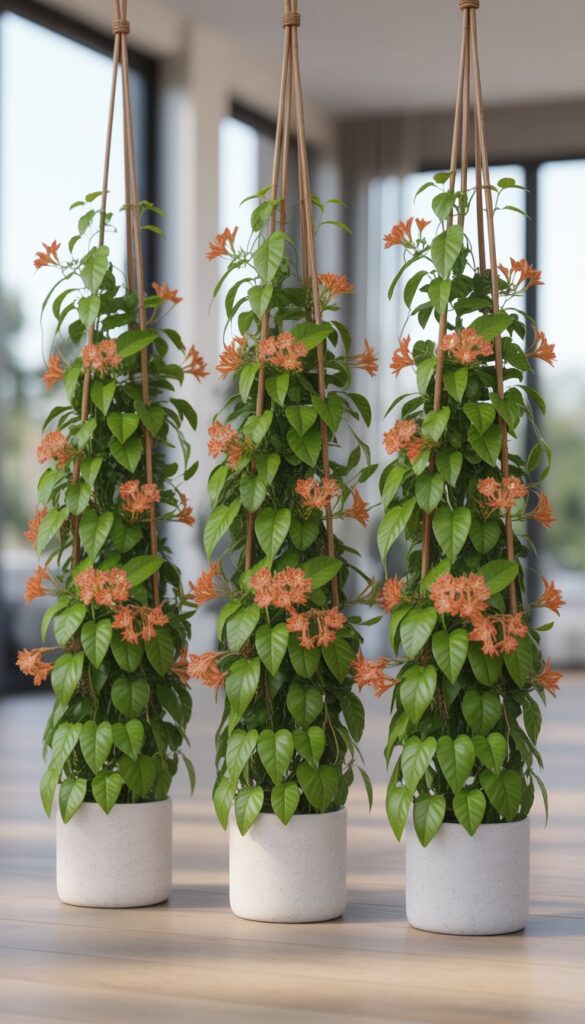
I like having Crossvine indoors because it grows fast and covers spaces with lush green leaves. Its bright, tubular flowers bloom from late winter to mid-summer—what a treat!
Crossvine likes a sturdy support, like a trellis or frame. Once it settles in, it doesn’t need much water, so I don’t worry if I forget a day or two.
If I keep it near a window, it attracts hummingbirds and butterflies, which is always fun to watch.
16. Jasmine (Jasminum polyanthum)
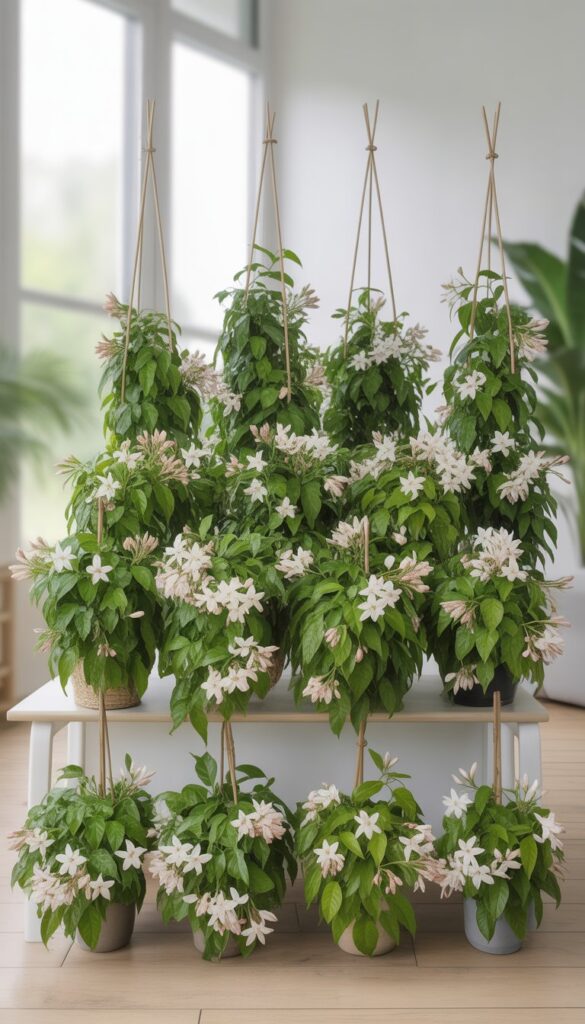
I enjoy growing Jasmine, especially Jasminum polyanthum, indoors. Its small, white flowers smell amazing, especially at night.
This jasmine climbs well on a trellis or support. It likes bright, indirect light and moderate watering—not too much, not too little.
Pruning after blooming helps keep it healthy. The scent and delicate flowers always make me smile.
17. Mandevilla
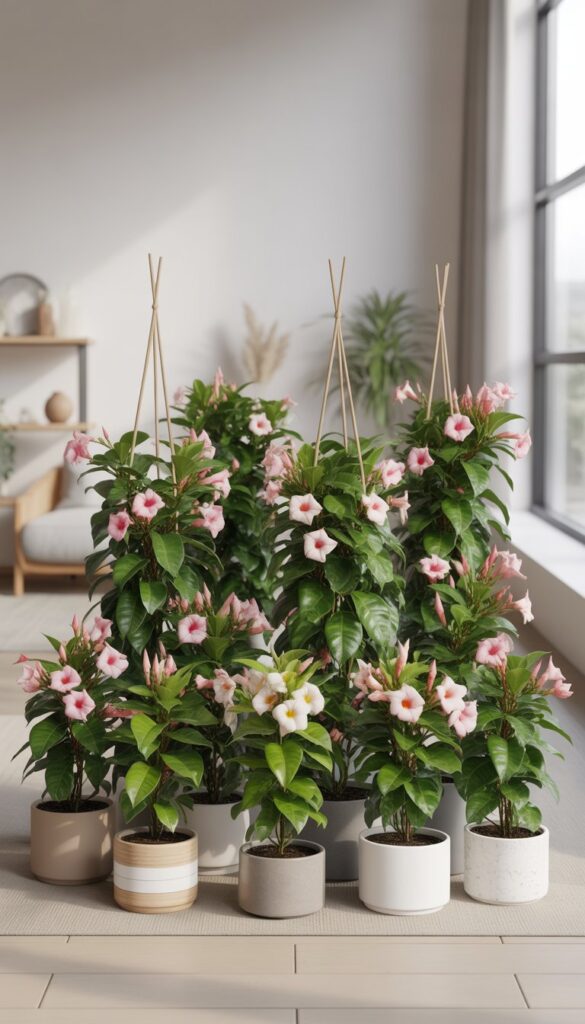
I love growing Mandevilla for its beautiful trumpet-shaped flowers. The stems twine easily, so it’s perfect for indoor trellises or supports.
This plant needs bright light and warmth. I keep the soil moist but not soggy, and I feed it every two weeks during the growing season.
Mandevilla isn’t winter hardy, so I always bring mine inside when it gets chilly. It adds a tropical feel to my home, with blooms in pink, red, or white.
18. Schizophragma hydrangeoides
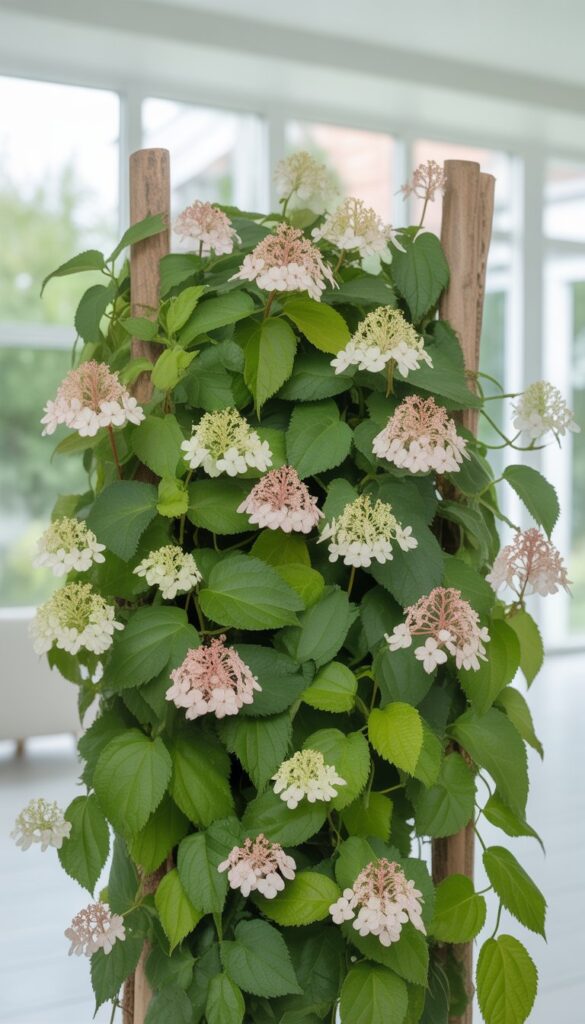
Schizophragma hydrangeoides climbs well indoors and really looks charming. Its heart-shaped leaves shift from purple to green, adding a bit of surprise each season.
The creamy-white flowers bloom in clusters, almost lace-like. This plant likes bright, indirect light and a bit of humidity—nothing too fancy.
If you want a climbing plant that’s easy to care for but still grabs attention, this one is a natural pick for a bright corner or near a window.
19. Black Jasmine (Trachelospermum jasminoides)

I enjoy growing Black Jasmine indoors. Its glossy, dark green leaves stay evergreen and the small white flowers fill the room with sweet fragrance.
This plant is easygoing. It prefers bright, indirect light and well-drained soil, and I water it when the top feels dry.
Black Jasmine can climb up a trellis or trail from a hanging basket, so it fits just about anywhere indoors.
20. Morning Glory (Ipomoea purpurea)
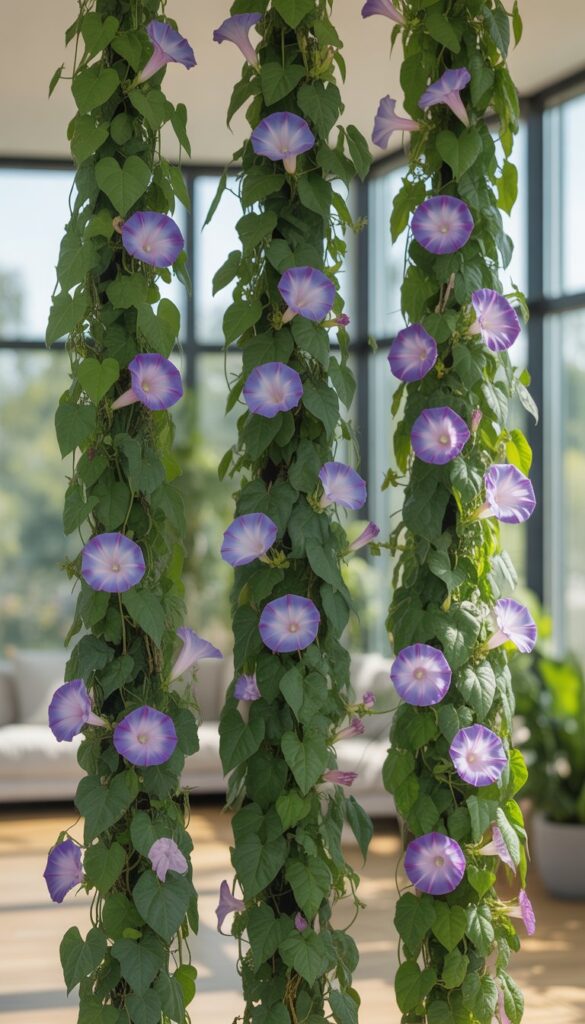
I like Morning Glory because it grows quickly and brightens up any room with its colorful flowers. It climbs easily on trellises or supports—couldn’t ask for more indoors.
This plant needs plenty of sunlight and well-drained soil. I water mine deeply but let the soil dry out between watering.
The flowers open in the morning and close by afternoon, which is a charming daily ritual to watch.
Essential Care Tips for Indoor Climbing Plants
Taking care of indoor climbing plants means paying attention to light, water, temperature, and how they like to grow. You’ll also want to find a support system that works—trellises, stakes, or whatever suits your style.
Light and Watering Requirements
Most indoor climbers prefer bright, indirect light. Direct sun can scorch their leaves, so I usually set mine near a window with filtered light or just out of the sun’s reach.
If your plant has dark green leaves, it might handle lower light, but those with variegated or lighter leaves need more brightness. Watering really depends on the plant and the season.
I check the soil by sticking my finger about an inch deep—if it feels dry, it’s time for a drink. Overwatering is easy to do, so I make sure pots have good drainage and don’t let the soil get soggy.
Most climbing plants like soil that’s lightly moist, never swampy. It’s a bit of a balancing act, honestly.
Ideal Temperature and Humidity
Indoor climbers usually thrive in temperatures between 65°F and 75°F (18°C to 24°C). I keep mine away from cold drafts or heaters, since sudden temperature changes can stress them out.
Humidity matters, too. Many climbing plants, like pothos or philodendrons, enjoy moderate to high humidity.
I’ll use a humidifier sometimes, or set a tray with water and pebbles nearby. Misting the leaves now and then helps, but only if the air isn’t already heavy with moisture.
Choosing the Right Support Structures
Climbers need something to grab as they reach upward. I like to use a mix of supports, depending on the plant’s size and the way it likes to climb.
- Trellises: Perfect for vertical growth and saving space.
- Moss poles: Let vines attach their aerial roots and soak up a bit of moisture.
- String or wire: Super simple for lightweight plants like ivy or string of hearts.
Pick supports that feel sturdy and are tall enough for your plant’s ambitions. I usually tie new shoots gently as they grow—just a nudge to keep things tidy and heading in the right direction.
